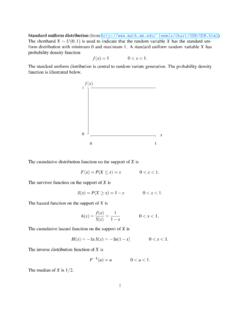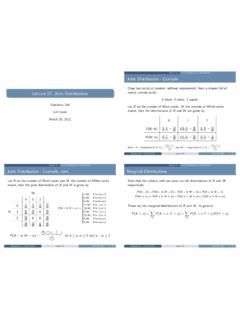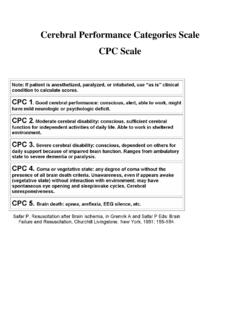Transcription of Univariate Distribution Relationships - William & Mary
1 Univariate Distribution RelationshipsLawrence M. LEEMISand Jacquelyn T. MCQUESTONP robability distributions are traditionally treated separately inintroductory mathematical statistics textbooks. A figure is pre-sented here that shows properties that individual distributionspossess and many of the Relationships between these WORDS: Asymptotic Relationships ; Distribution proper-ties; Limiting distributions; Stochastic parameters; INTRODUCTIONI ntroductory probability and statistics textbooks typically in-troduce common Univariate distributions individually, and sel-dom report all of the Relationships between these article contains an update of a figure presented by Leemis(1986) that shows the properties of and Relationships betweenseveral common Univariate distributions.
2 More detail concern-ing these distributions is given by Johnson, Kotz, and Balakrish-nan (1994, 1995) and Johnson, Kemp, and Kotz (2005). Moreconcise treatments are given by Balakrishnan and Nevzorov(2003), Evans, Hastings, and Peacock (2000), Ord (1972), Pa-tel, Kapadia, and Owen (1976), Patil, Boswell, Joshi, and Rat-naparkhi (1985), Patil, Boswell, and Ratnaparkhi (1985), andShapiro and Gross (1981). Figures similar to the one presentedhere have appeared in Casella and Berger (2002), Marshall andOlkin (1985), Nakagawa and Yoda (1977), Song (2005), andTaha (1982).Figure 1 contains 76 Univariate probability are 19 discrete and 57 continuous models.
3 Discrete distri-butions are displayed in rectangular boxes; continuous distribu-tions are displayed in rounded boxes. The discrete distributionsare at the top of the figure, with the exception of theBenfordLawrence M. Leemis is a Professor, Department of Mathematics, TheCollege of William & Mary, Williamsburg, VA 23187 8795 Jacquelyn T. McQueston is an Operations Researcher,Northrop Grumman Corporation, Chantilly, VA 20151. The authors are grate-ful for the support from The College of William & Mary through a summerresearch grant, a faculty research assignment, and a NSF CSEMS grant DUE 0123022. They also express their gratitude to the students in CS 688 at William & Mary, the editor, a referee, Bruce Schmeiser, John Drew, and Diane Evansfor their careful proofreading of this article.
4 Please e-mail the first author withupdates and corrections to the chart given in this article, which will be posted A Distribution is described by two lines of text ineach box. The first line gives the name of the Distribution and itsparameters. The second line contains the properties (describedin the next section) that the Distribution parameterizations for the distributions are given in theAppendix. If the Distribution is known by several names ( ,the normal Distribution is often called the Gaussian distribu-tion), this is indicated in the Appendix following the name ofthe Distribution . The parameters typically satisfy the followingconditions: n, with or without subscripts, is a positive integer; pis a parameter satisfying 0<p<1; and , with or without subscripts, are positive scale pa-rameters; , , and are positive shape parameters; ,a, andbare location parameters; and are positive to these rules, such as the rectangular parametern,are given in the Appendix after any aliases for the , any parameters not described above are explic-itly listed in the Appendix.
5 Many of the distributions have sev-eral mathematical forms, only one of which is presented here( , the extreme value and discrete Weibull distributions) forthe sake of are numerous distributions that have not been in-cluded in the chart due to space limitations or that the dis-tribution is not related to one of the distributions currentlyon the chart. These include B ezier curves (Flanigan Wagnerand Wilson 1993); the Burr Distribution (Crowder et al. 1991,p. 33 and Johnson, Kotz, and Balakrishnan 1994, pp. 15 63); the generalized beta Distribution (McDonald 1984); thegeneralized exponential Distribution (Gupta and Kundu 2007);the generalizedFdistribution (Prentice 1975); Johnson curves(Johnson, Kotz, and Balakrishnan 1994, pp.)
6 15 63); the kappadistribution (Hosking 1994); the Kolmogorov Smirnov one-sample Distribution (parameters estimated from data), theKolmogorov Smirnov two-sample Distribution (Boomsma andMolenaar 1994); the generalized lambda Distribution (Rambergand Schmeiser 1974); the Maxwell Distribution (Balakrishnanand Nevzorov 2003, p. 232); Pearson systems (Johnson, Kotz,and Balakrishnan 1994, pp. 15 63); the generalized Waring dis-tribution (Hogg, McKean, and Craig 2005, p. 195). Likewise,c 2008 American Statistical Association DOI: American Statistician, February 2008, Vol. 62, No. 1 45 Devroye (2006) refers to Dickman s, Kolmogorov Smirnov,Kummer s, Linnik Laha, theta, and de la Vall ee Poussin dis-tributions in his chapter on variate Distribution PROPERTIEST here are several properties that apply to individual distribu-tions listed in Figure 1.
7 Thelinear combinationproperty (L) indicates that lin-ear combinations of independent random variables havingthis particular Distribution come from the same : IfXi N( i, 2i)fori=1,2,..,n;a1,a2,..,anare real constants, andX1,X2,..,Xnareindependent, thenn i=1aiXi N(n i=1ai i,n i=1a2i 2i). Theconvolutionproperty (C) indicates that sums of inde-pendent random variables having this particular distribu-tion come from the same Distribution : IfXi 2(ni)fori= 1, 2, ..,n, andX1,X2,..,Xnare independent, thenn i=1Xi 2(n i=1ni). Thescalingproperty (S) implies that any positive realconstant times a random variable having this distributioncomes from the same Distribution : IfX Weibull( , ) andkis a positive, realconstant, thenkX Weibull( k , ).
8 Theproductproperty (P) indicates that products of inde-pendent random variables having this particular distribu-tion come from the same Distribution : IfXi lognormal( i, 2i)fori=1,2,..,n,andX1,X2,..,Xnare independent, thenn i=1Xi lognormal(n i=1 i,n i=1 2i). Theinverseproperty (I) indicates that the reciprocal of arandom variable of this type comes from the same distri-bution : IfX F(n1,n2), then1X F(n2,n1). Theminimumproperty (M) indicates that the smallest ofindependent and identically distributed random variablesfrom a Distribution comes from the same Distribution : IfXi exponential( i)fori= 1, 2, ..,n, andX1,X2,..,Xnare independent, thenmin{X1,X2.}
9 ,Xn} exponential(1/n i=1(1/ i)). Themaximumproperty (X) indicates that the largest ofindependent and identically distributed random variablesfrom a Distribution comes from the same Distribution : IfXi standard power ( i) fori=1,2,..,n,andX1,X2,..,Xnare independent, thenmax{X1,X2,..,Xn} standard power(n i=1 i). Theforgetfulnessproperty (F), more commonly known asthe memoryless property, indicates that the conditional dis-tribution of a random variable is identical to the uncondi-tional Distribution . The geometric and exponential distri-butions are the only two distributions with this property is a special case of the residual property.
10 Theresidualproperty (R) indicates that the conditionaldistribution of a random variable left-truncated at a valuein its support belongs to the same Distribution family as theunconditional : IfX Uniform(a,b), andkis a real constantsatisfyinga<k<b, then the conditional Distribution ofXgivenX>kbelongs to the uniform family. Thevariate generationproperty (V) indicates that the in-verse cumulative Distribution function of a continuous ran-dom variable can be expressed in closed form. For a dis-crete random variable, this property indicates that a variatecan be generated in anO(1)algorithm that does not cyclethrough the support values or rely on a special : IfX exponential( ), thenF 1(u)= log(1 u),0<u< property L implies properties C and S, the C and Sproperties are not listed on a Distribution having the L , propertyF) of the properties apply only in restricted cases.













